Abstract
This study was aimed to examine the prevalence of food insecurity and what social, health, and environmental characteristics could constitute such situation in a national and population-based setting. Data was retrieved from the National Health and Nutrition Examination Survey, 2005–2006. Information on demographics, lifestyle factors, self-reported ever medical conditions in the past and self-reported food security conditions in the last 12 months calculated on the household level was obtained by household interview. Bloods and urines (subsample) were collected at the interview as well. Only adults aged 20 years and above (n = 4979) were included for statistical analysis in the present study. Chi-square test, t test, and survey-weighted logistic regression modeling were performed. Three thousand eight hundred thirty-four (77.9 %) people were with full food security, 466 (9.5 %) people were with marginal food security and 624 (12.7 %) people were with low or very low food security. Being younger, having higher ratios of family income to poverty thresholds (due to low level of education or lack of financial support), having prior asthma, arthritis, chronic bronchitis, depression, diabetes, eczema, emphysema or liver problems, having higher levels of serum cotinine, urinary antimony, bisphenol A, pesticides, or having lower levels of urinary Benzophenone-3 were associated with food insecurity. In addition to socioeconomic and smoking conditions, evidence on people with several prior health conditions and being exposed to environmental chemicals and food insecurity is further provided. Future social, health and environmental policy, and programs protecting people from food insecurity by considering both health and environmental factors mentioned above would be suggested.
Similar content being viewed by others
References
Alaimo K, Olson CM, Frongillo EA Jr (2001) Low family income and food insufficiency in relation to overweight in US children: is there a paradox? Arch Pediatr Adolesc Med 155:1161–1167
Álvarez-Hernández E, Peláez-Ballestas I, Boonen A, Vázquez-Mellado J, Hernández-Garduño A, Rivera FC, Teran-Estrada L, Ventura-Ríos L, Ramos-Remus C, Skinner-Taylor C, Goycochea-Robles MV, Bernard-Medina AG, Burgos-Vargas R (2012) Catastrophic health expenses and impoverishment of households of patients with rheumatoid arthritis. Reumatol Clin 8:168–173
Berkowitz SA (2014) Seligman HK2, Choudhry NK3. Treat or eat: food insecurity, cost-related medication underuse, and unmet needs. Am J Med 127:303–310
Brewer DP, Catlett CS, Porter KN, Lee JS, Hausman DB, Reddy S, Johnson MA (2010) Physical limitations contribute to food insecurity and the food insecurity-obesity paradox in older adults at senior centers in Georgia. J Nutr Elder 29:150–169
Carneiro FF, Tambellini AT, Silva JA, Haddad JP, Búrigo AC, Sá WR, Viana FC, Bertolini VA (2008) Health of families from the Landless Workers' Movement and temporary rural workers, Brazil, 2005. Rev Saude Publica 42:757–763
Date AR, Gray AL (1989) Applications of inductively coupled plasma mass spectrometry. Chapman and Hall, NY
Ford ES (2013) Food security and cardiovascular disease risk among adults in the United States: findings from the National Health and Nutrition Examination Survey, 2003–2008. Prev Chronic Dis 10, E202
Galesloot S, McIntyre L, Fenton T, Tyminski S (2012) Food insecurity in Canadian adults receiving diabetes care. Can J Diet Pract Res 73:e261–e266
Guthrie JF, Lin BH (2002) Overview of the diets of lower- and higher-income elderly and their food assistance options. J Nutr Educ Behav 34(Suppl 1):S31–S41
Laraia BA, Borja JB, Bentley ME (2009) Grandmothers, fathers, and depressive symptoms are associated with food insecurity among low-income first-time African-American mothers in North Carolina. J Am Diet Assoc 109:1042–1047
Mulligan KJ, Davidson TM, Caruso JA (1990) Feasibility of the direct analysis of Urine by inductively coupled argon plasma mass-spectrometry for biological monitoring of exposure to metals. J Anal Atom Spectrom 5:301–306
Nelson JW, Scammell MK, Hatch EE, Webster TF (2012) Social disparities in exposures to bisphenol A and polyfluoroalkyl chemicals: a cross-sectional study within NHANES 2003–2006. Environ Health 11:10
Poon R, Chu I, Lecavalier P, Valli VE, Foster W, Gupta S, Thomas B (1998) Effects of antimony on rats following 90-day exposure via drinking water. Food Chem Toxicol 36:21–35
Sattler EL, Lee JS (2013) Persistent food insecurity is associated with higher levels of cost-related medication nonadherence in low-income older adults. J Nutr Gerontol Geriatr 32:41–58
Seligman HK, Laraia BA, Kushel MB (2010) Food insecurity is associated with chronic disease among low-income NHANES participants. J Nutr 140:304–310
Silva MJ, Samandar E, Preau JL Jr, Reidy JA, Needham LL, Calafat AM (2007) J Chromatogr B Analyt Technol Biomed Life Sci 860:106–112
Tayie FA, Zizza CA (2010) Concerns about the secondary data analysis of the association between food insecurity and hyperlipidemia in low-income NHANES participants. J Nutr 140:1535
Viberg H, Lee I (2012) A single exposure to bisphenol A alters the levels of important neuroproteins in adult male and female mice. Neurotoxicology 33:1390–1395
Westgard JO, Barry PL, Hunt MR (1981) Clin Chem 27:493
Xu B, Locher J, Lee JS, Buys D, Zizza CA (2011) Smoking modifies the association between food insecurity and physical performance. J Nutr Gerontol Geriatr 30:140–153
Ye XY, Kuklenyik Z, Needham LL, Calafat AM (2005) Anal Chem 77:5407–5413
Ye XY, Kuklenyik Z, Bishop AM, Needham LL, Calafat AM (2006) J Chromatogr B-Anal Technol Biomed Life Sci 844:53–59
Acknowledgements
None.
Author information
Authors and Affiliations
Corresponding author
Ethics declarations
Conflict of interest
The author declared no conflict of interest.
Additional information
Responsible editor: Philippe Garrigues
Rights and permissions
About this article
Cite this article
Shiue, I. People with diabetes, respiratory, liver or mental disorders, higher urinary antimony, bisphenol A, or pesticides had higher food insecurity: USA NHANES, 2005–2006. Environ Sci Pollut Res 23, 198–205 (2016). https://doi.org/10.1007/s11356-015-5677-y
Received:
Accepted:
Published:
Issue Date:
DOI: https://doi.org/10.1007/s11356-015-5677-y




